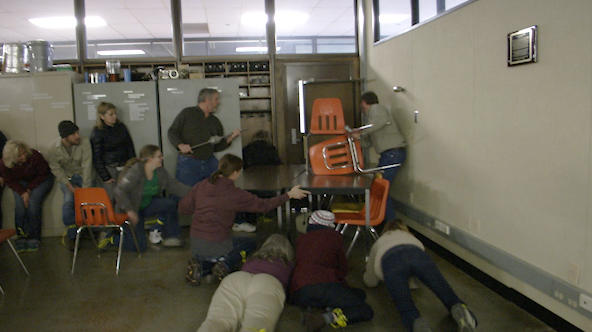Yesterday we discussed the successful changes made by the nation of Israel to stop their rampant school shootings. They fortified every school in the country, locking each facility down while making each facility impervious to “normal” school shooting incidents. These measures included complete fencing, a “one-way-in” and “one-way-out” access process, armed teachers and administrators, and constant “practice” drills to prepare for the “next” school shooter.
These processes were implemented in 1974. Since then, only two shootings have happened. One can honestly say those measures happened.
But it’s one thing to prepare and fortify a school facility. It’s another to identify who these probable school shooters are BEFORE they play out a mass shooting scheme. It sounds impossible to do, but because there have been so many school shootings — most of which were perpetrated by shooters with remarkably similar life circumstances — many psychological experts have identified several common traits that may be watched for in students who may be the next school shooter. The similarities will probably surprise you.
What do school attackers have in common?
In addition to often exhibiting signs of increasingly violent and dysfunctional behavior, they are significantly more likely than the average population to suffer from undiagnosed or untreated mental illness; they often come from broken homes, and their shootings may be related to economic insecurity.
Let’s take a closer look at these factors.
1. Mental Illness
Even when serious mental illness is not present, school attackers almost always exhibit common traits of extreme resentfulness, anger, and a desire for revenge because of perceived social alienation. It is not uncommon for a school attacker to have acted increasingly disruptive and violent ways before the shooting. But for a variety of reasons, these individuals are often not involuntarily committed to a mental health institution or ordered by a court to receive mental health treatment.
This does not mean that mental health disorders are synonymous with violence — the vast majority of individuals suffering from mental health disorders will never commit violent acts. However, it does mean that the early identification and treatment of students with mental health disorders is of particular importance in reducing large-scale violent attacks at schools.
School attackers often “leak” their intentions to their peers, whether in person or via social media. One of the Columbine attackers wrote online blogs that included statements about his desire to kill those who annoyed him, as well as specific violent threats directed against his classmates and teachers. Before gunning down 17 students in Florida, the Parkland attacker was reported to the FBI for a YouTube posting in which he bragged about becoming a “professional school shooter.” He also reportedly joked to classmates on numerous occasions that he would be the one to “shoot up a school.”
It is also not uncommon for school attackers to show more indirect warning signs, such as an unhealthy fixation on firearms, writing projects focused on grotesque violence or praising other infamous school attackers.
Teachers and other school professionals must be attuned to these warning signs and take appropriate action, including engaging with outside mental health professionals and local law enforcement officials.
2. Broken Homes
Familial dynamics may also play a role in the early detection of students on the verge of committing catastrophic acts of violence. Sadly, most school attackers come from broken homes, often growing up with absent fathers or during a divorce or domestic violence.
♦♦♦ The Parkland attacker, raised alone by his adoptive mother since the age of six, was merely the latest in a long line of troubled young men who grew up in less than ideal family situations.
♦♦♦ The shooters at Sandy Hook, Chadron High School, Isla Vista, SuccessTech Academy, Northern Illinois University, and Santana High School (to name a few) all had divorced parents.
♦♦♦ The young man who killed his grandfather before murdering seven of his classmates at Red Lake Senior High School had parents who never married, a father who shot himself, and a mother and stepfather who divorced. He also lived with a grandmother who was separated from her husband.
This does not mean that all students with complicated home lives should be considered potential school attackers. Students with intact, stable families should have troubling behaviors overlooked or dismissed. However, it may mean that holistic approaches to school safety should include an appreciation of the impact that a chaotic family life can have on a student’s feelings of desperation and violent actions.
The unfortunate fact that broken family relationships are often associated with more significant risk factors for youths is nothing new. For decades, study after study has shown that stable, intact families play a vital role in developing thriving children and adolescents. Adolescents living in intact families are less likely to exhibit violent behaviors or engage in physical fighting. In addition, youths in fatherless homes are significantly more likely to be incarcerated than those from two-parent homes.
Several studies have found that adolescents from intact families tend to report lower emotional and psychological stress levels. At the same time, those who do not live with both biological parents are more likely to exhibit affective psychological disorders such as hyperactivity, irritability, and depression as adults.
The importance of having actively involved fathers and father figures cannot be overstated when it comes to children’s mental and emotional development. Fathers are important role models for sons. They play a crucial role in helping to maintain authority and discipline in the home. They help with self-control and feelings of empathy toward others — key character traits violent youth often lack.
Psychologist Marsha Kline Pruett notes that “[f]athers tend to be more willing than mothers to confront their children and enforce discipline, leaving their children with the impression that they have more authority.”
3. Economic Insecurity
Socioeconomic trends may identify further risk factors related to school violence. A significant study by criminologists at Northwestern University looked at the effect of economic conditions on the prevalence of school shootings. It concluded that there is a considerable correlation between periods of increased economic insecurity and increased gun violence at schools. The findings are particularly robust in that the effects are seen across several different economic indicators. The relationship remains even when analyzing the data at national, regional, and city levels. The researchers noted that the results of this study are in line with other evidence that joblessness is related to low self-esteem and detrimental behavior, that minors are responsive to their parents’ unemployment, and that the attitudes of youths have a significant impact on their future economic outcomes.
They further posited that “gun violence at schools is a response, in part, to the breakdown of the expectation that sustained participation in the educational system will improve economic opportunities and outcomes.” This suggestion is profound in the context of the backgrounds of many individuals who commit violent attacks at schools and were either struggling to finish or failed to complete their educations and had limited future economic opportunities.
♦♦♦ The Sandy Hook attacker was removed from high school by his parents due to sensory-integration disorder, failed to obtain a degree after attending classes at Western Connecticut State University, and was unemployed without any likelihood of holding a job soon.
♦♦♦ The Parkland attacker had been expelled from high school for disciplinary problems, took adult education classes to get his GED, and worked at a Dollar Store.
♦♦♦ The Isla Vista attacker graduated high school but dropped out of a local college within a year and was investigated by local law enforcement because of concerns about the state of his mental health.
Tackling the Root Problems
Real solutions to problems start with facts, and the truth is that school shooters often share the same traits — traits that are not connected to or related to guns.
Suppose we are going to get serious about school safety. In that case, we must soberly acknowledge the fact that mental illness, broken families, and economic insecurity all play a role in many, if not most, school shootings.
Addressing those societal ills with proven strategies will help reduce school shootings and other violent acts by at-risk youth.
Summary
 The most challenging time in the cycle of school shootings is in the immediate aftermath. The struggles are obvious: tending to the medical and psychological needs of all survivors and their family members; the sense of permanent loss for all those who lost loved ones in the attacks; the fear that, in many cases, becomes permanent with a constant thought of “could this happen again and impact me?”
The most challenging time in the cycle of school shootings is in the immediate aftermath. The struggles are obvious: tending to the medical and psychological needs of all survivors and their family members; the sense of permanent loss for all those who lost loved ones in the attacks; the fear that, in many cases, becomes permanent with a constant thought of “could this happen again and impact me?”
The Israel example of how to physically prevent a school shooter from wiping out numerous students and educators needs to be implemented, at least in part, in every school across the U.S. to some degree. (I urge you to read the May 26, 2022 story we published at www.TruthNewsNet.org that details that plan) But security to the level achieved in Israel may not be possible in every circumstance. Even if it should become the “norm” for school facilities in the U.S., there will still be situations for which there is no preemptive plan for those contingencies.
This is an ongoing and permanent process. It needs to begin across the nation immediately and be revised and refined periodically to cover ALL newly discovered ways for perpetrators to attempt another mass school shooting.
Here’s the bottom line: no one can prepare for every contingency. But a coordinated template that covers the nuances of every location can do more than stop a would-be school shooter. It can legitimately provide solace for students, educators, law enforcement, and parents knowing that the likelihood of another Uvalde is not likely.
Wouldn’t it be wonderful to accurately feel all these people are safe every time they are on campus?

